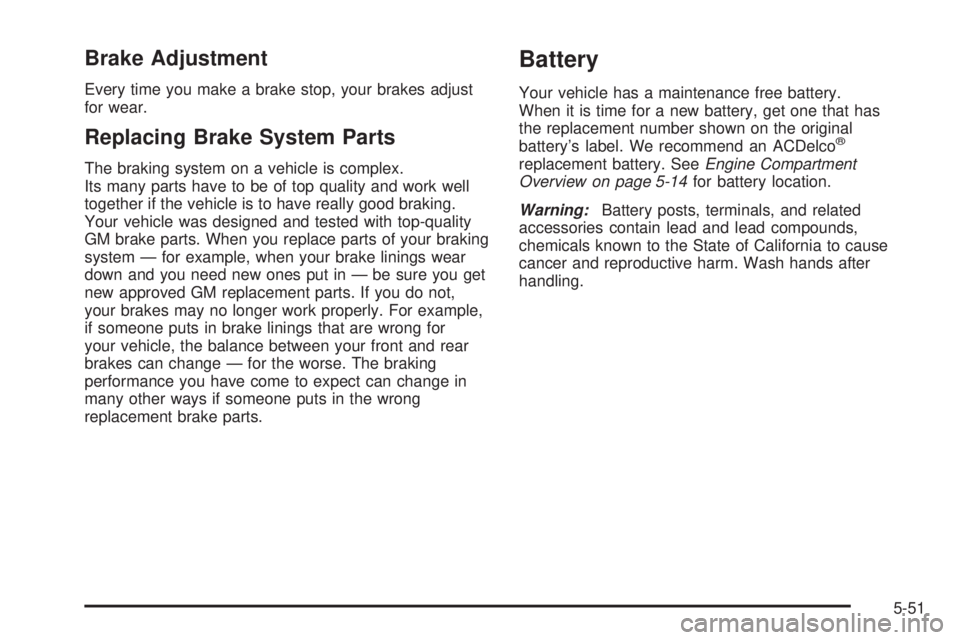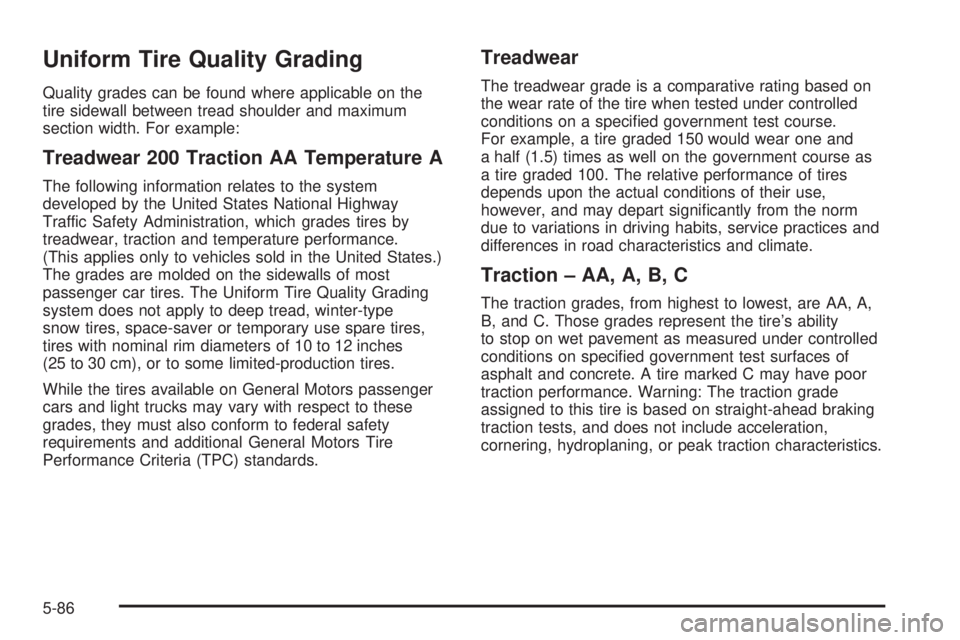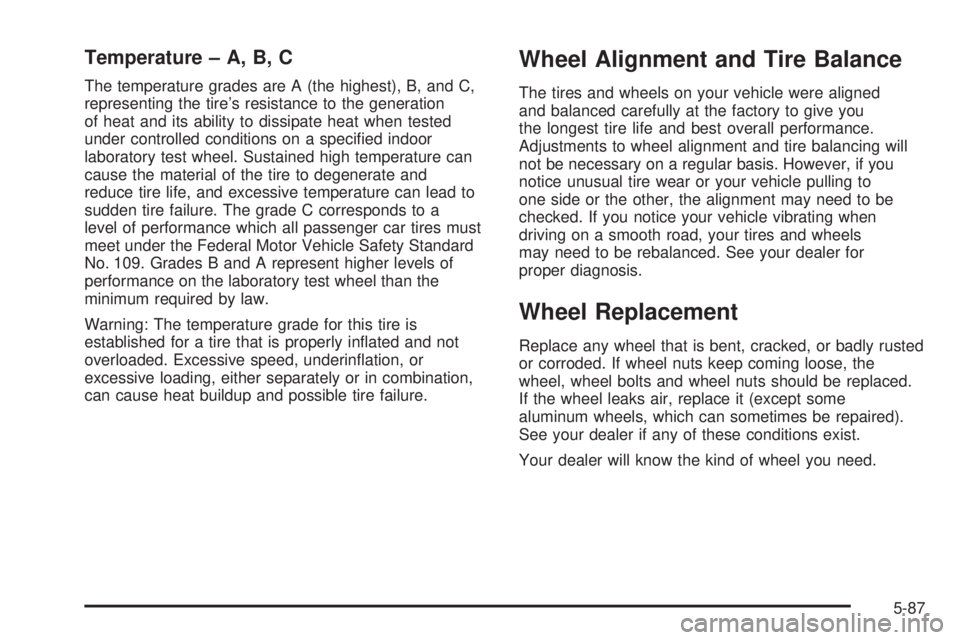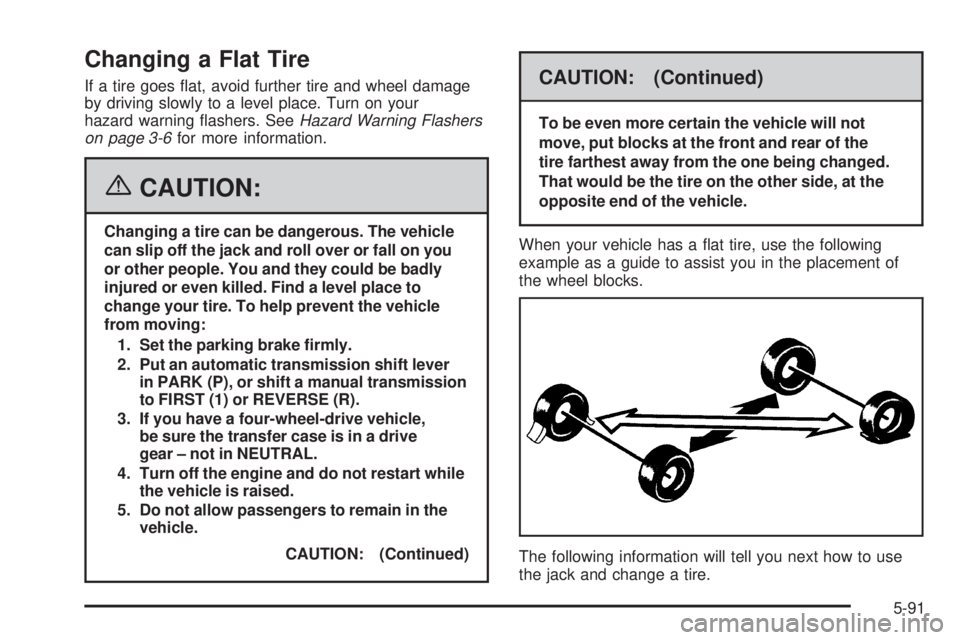2006 GMC SIERRA warning
[x] Cancel search: warningPage 463 of 600

Brake Adjustment
Every time you make a brake stop, your brakes adjust
for wear.
Replacing Brake System Parts
The braking system on a vehicle is complex.
Its many parts have to be of top quality and work well
together if the vehicle is to have really good braking.
Your vehicle was designed and tested with top-quality
GM brake parts. When you replace parts of your braking
system — for example, when your brake linings wear
down and you need new ones put in — be sure you get
new approved GM replacement parts. If you do not,
your brakes may no longer work properly. For example,
if someone puts in brake linings that are wrong for
your vehicle, the balance between your front and rear
brakes can change — for the worse. The braking
performance you have come to expect can change in
many other ways if someone puts in the wrong
replacement brake parts.
Battery
Your vehicle has a maintenance free battery.
When it is time for a new battery, get one that has
the replacement number shown on the original
battery’s label. We recommend an ACDelco
®
replacement battery. SeeEngine Compartment
Overview on page 5-14for battery location.
Warning:Battery posts, terminals, and related
accessories contain lead and lead compounds,
chemicals known to the State of California to cause
cancer and reproductive harm. Wash hands after
handling.
5-51
Page 498 of 600

Uniform Tire Quality Grading
Quality grades can be found where applicable on the
tire sidewall between tread shoulder and maximum
section width. For example:
Treadwear 200 Traction AA Temperature A
The following information relates to the system
developed by the United States National Highway
Traffic Safety Administration, which grades tires by
treadwear, traction and temperature performance.
(This applies only to vehicles sold in the United States.)
The grades are molded on the sidewalls of most
passenger car tires. The Uniform Tire Quality Grading
system does not apply to deep tread, winter-type
snow tires, space-saver or temporary use spare tires,
tires with nominal rim diameters of 10 to 12 inches
(25 to 30 cm), or to some limited-production tires.
While the tires available on General Motors passenger
cars and light trucks may vary with respect to these
grades, they must also conform to federal safety
requirements and additional General Motors Tire
Performance Criteria (TPC) standards.
Treadwear
The treadwear grade is a comparative rating based on
the wear rate of the tire when tested under controlled
conditions on a speci�ed government test course.
For example, a tire graded 150 would wear one and
a half (1.5) times as well on the government course as
a tire graded 100. The relative performance of tires
depends upon the actual conditions of their use,
however, and may depart signi�cantly from the norm
due to variations in driving habits, service practices and
differences in road characteristics and climate.
Traction – AA, A, B, C
The traction grades, from highest to lowest, are AA, A,
B, and C. Those grades represent the tire’s ability
to stop on wet pavement as measured under controlled
conditions on speci�ed government test surfaces of
asphalt and concrete. A tire marked C may have poor
traction performance. Warning: The traction grade
assigned to this tire is based on straight-ahead braking
traction tests, and does not include acceleration,
cornering, hydroplaning, or peak traction characteristics.
5-86
Page 499 of 600

Temperature – A, B, C
The temperature grades are A (the highest), B, and C,
representing the tire’s resistance to the generation
of heat and its ability to dissipate heat when tested
under controlled conditions on a speci�ed indoor
laboratory test wheel. Sustained high temperature can
cause the material of the tire to degenerate and
reduce tire life, and excessive temperature can lead to
sudden tire failure. The grade C corresponds to a
level of performance which all passenger car tires must
meet under the Federal Motor Vehicle Safety Standard
No. 109. Grades B and A represent higher levels of
performance on the laboratory test wheel than the
minimum required by law.
Warning: The temperature grade for this tire is
established for a tire that is properly in�ated and not
overloaded. Excessive speed, underin�ation, or
excessive loading, either separately or in combination,
can cause heat buildup and possible tire failure.
Wheel Alignment and Tire Balance
The tires and wheels on your vehicle were aligned
and balanced carefully at the factory to give you
the longest tire life and best overall performance.
Adjustments to wheel alignment and tire balancing will
not be necessary on a regular basis. However, if you
notice unusual tire wear or your vehicle pulling to
one side or the other, the alignment may need to be
checked. If you notice your vehicle vibrating when
driving on a smooth road, your tires and wheels
may need to be rebalanced. See your dealer for
proper diagnosis.
Wheel Replacement
Replace any wheel that is bent, cracked, or badly rusted
or corroded. If wheel nuts keep coming loose, the
wheel, wheel bolts and wheel nuts should be replaced.
If the wheel leaks air, replace it (except some
aluminum wheels, which can sometimes be repaired).
See your dealer if any of these conditions exist.
Your dealer will know the kind of wheel you need.
5-87
Page 503 of 600

Changing a Flat Tire
If a tire goes �at, avoid further tire and wheel damage
by driving slowly to a level place. Turn on your
hazard warning �ashers. SeeHazard Warning Flashers
on page 3-6for more information.
{CAUTION:
Changing a tire can be dangerous. The vehicle
can slip off the jack and roll over or fall on you
or other people. You and they could be badly
injured or even killed. Find a level place to
change your tire. To help prevent the vehicle
from moving:
1. Set the parking brake �rmly.
2. Put an automatic transmission shift lever
in PARK (P), or shift a manual transmission
to FIRST (1) or REVERSE (R).
3. If you have a four-wheel-drive vehicle,
be sure the transfer case is in a drive
gear – not in NEUTRAL.
4. Turn off the engine and do not restart while
the vehicle is raised.
5. Do not allow passengers to remain in the
vehicle.
CAUTION: (Continued)
CAUTION: (Continued)
To be even more certain the vehicle will not
move, put blocks at the front and rear of the
tire farthest away from the one being changed.
That would be the tire on the other side, at the
opposite end of the vehicle.
When your vehicle has a �at tire, use the following
example as a guide to assist you in the placement of
the wheel blocks.
The following information will tell you next how to use
the jack and change a tire.
5-91
Page 587 of 600

A
Accessories and Modi�cations............................ 5-4
Accessory Power Outlet(s)...............................3-20
Adding a Snow Plow or Similar Equipment.........4-54
Adding Equipment to Your Airbag-Equipped
Vehicle.......................................................1-86
Additives, Fuel................................................. 5-7
Add-On Electrical Equipment...........................5-123
Air Cleaner/Filter, Engine.................................5-25
Air Conditioning..............................3-21, 3-22, 3-25
Airbag
Off Light.....................................................3-35
Passenger Status Indicator...........................3-37
Readiness Light..........................................3-35
Airbag Sensing and Diagnostic Module (SDM)...... 7-9
Airbag System................................................1-70
Adding Equipment to Your Airbag-Equipped
Vehicle...................................................1-86
Airbag Off Switch........................................1-78
How Does an Airbag Restrain?......................1-76
Passenger Sensing System...........................1-81
Servicing Your Airbag-Equipped Vehicle..........1-86
What Makes an Airbag In�ate?......................1-76
What Will You See After an Airbag In�ates?....1-76
When Should an Airbag In�ate?....................1-74
Where Are the Airbags?...............................1-72
AM-FM Radio.................................................3-72
Antenna, Fixed Mast......................................3-132
Antenna, XM™ Satellite Radio Antenna System . . . 3-133Anti-Lock Brake System (ABS)........................... 4-6
Anti-Lock Brake, System Warning Light..............3-42
Appearance Care
Aluminum or Chrome-Plated Wheels.............5-118
Care of Safety Belts...................................5-116
Chemical Paint Spotting..............................5-120
Cleaning Exterior Lamps/Lenses..................5-117
Cleaning the Inside of Your Vehicle..............5-113
Fabric/Carpet............................................5-114
Finish Care...............................................5-117
Finish Damage..........................................5-120
Instrument Panel, Vinyl, and Other
Plastic Surfaces.....................................5-115
Leather....................................................5-115
Sheet Metal Damage..................................5-119
Tires........................................................5-119
Underbody Maintenance.............................5-120
Vehicle Care/Appearance Materials...............5-121
Washing Your Vehicle.................................5-116
Weatherstrips............................................5-116
Windshield and Wiper Blades......................5-118
Ashtray(s)......................................................3-20
Audio System(s).............................................3-70
AM-FM Radio.............................................3-72
Audio Steering Wheel Controls....................3-129
Care of Your Cassette Tape Player...............3-131
Care of Your CD and DVD Player................3-132
Care of Your CDs and DVDs.......................3-132
Chime Level Adjustment.............................3-133
Fixed Mast Antenna...................................3-132
1
Page 588 of 600

Audio System(s) (cont.)
Radio with Cassette and CD.........................3-85
Radio with CD............................................3-75
Radio with Six-Disc CD..............................3-100
Rear Seat Audio (RSA)...............................3-127
Setting the Time for Radios with
Radio Data Systems (RDS).......................3-71
Setting the Time for Radios without
Radio Data Systems (RDS).......................3-71
Theft-Deterrent Feature...............................3-129
Understanding Radio Reception...................3-130
XM™ Satellite Radio Antenna System...........3-133
Automatic Headlamp System............................3-15
Automatic Transmission
Fluid..................................................5-28, 5-30
Operation...................................................2-26
Auxiliary Roof Mounted Lamp Switch.................3-18
B
Battery..........................................................5-51
Battery Warning Light......................................3-40
Before Leaving on a Long Trip.........................4-38
Brake
Anti-Lock Brake System (ABS)........................ 4-6
Emergencies................................................ 4-8
Parking......................................................2-52
System Warning Light..................................3-41
Brakes..........................................................5-47
Braking........................................................... 4-5Braking in Emergencies..................................... 4-8
Break-In, New Vehicle.....................................2-21
Bulb Replacement...........................................5-63
Center High-Mounted Stoplamp (CHMSL) and
Cargo Lamp............................................5-67
Front Turn Signal, Sidemarker and Daytime
Running Lamps........................................5-64
Halogen Bulbs............................................5-63
Headlamps.................................................5-63
Pickup Box Identi�cation and Fender
Marker Lamps.........................................5-68
Replacement Bulbs......................................5-70
Roof Marker Lamps.....................................5-66
Taillamps, Turn Signal, Stoplamps and
Back-up Lamps........................................5-68
Buying New Tires...........................................5-84
C
California Fuel.................................................. 5-7
California Proposition 65 Warning....................... 5-4
Canadian Owners................................................ ii
Capacities and Speci�cations..........................5-133
Carbon Monoxide...................2-14, 2-57, 4-42, 4-67
Care of
Safety Belts..............................................5-116
Your Cassette Tape Player..........................3-131
Your CD and DVD Player...........................3-132
Your CDs and DVDs..................................3-132
Cargo Lamp...................................................3-19
2
Page 590 of 600

Cooling System..............................................5-40
Cruise Control................................................3-10
Cruise Control Light........................................3-49
Cupholder(s)..................................................2-79
Customer Assistance Information
Courtesy Transportation.................................. 7-7
Customer Assistance for Text
Telephone (TTY) Users............................... 7-4
Customer Assistance Offices........................... 7-4
Customer Satisfaction Procedure..................... 7-2
GM Mobility Reimbursement Program............... 7-5
Reporting Safety Defects to General Motors....7-14
Reporting Safety Defects to the Canadian
Government............................................7-14
Reporting Safety Defects to the United States
Government............................................7-13
Roadside Assistance Program......................... 7-6
Service Publications Ordering Information........7-15
D
Daytime Running Lamps..................................3-15
Defensive Driving............................................. 4-2
Delayed Locking.............................................2-10
Doing Your Own Service Work........................... 5-5
Dome Lamp Override......................................3-19
Dome Lamps.................................................3-18
Door
Delayed Locking..........................................2-10
Locks.......................................................... 2-8Door (cont.)
Power Door Locks......................................... 2-9
Programmable Automatic Door Locks.............2-10
Rear Door Security Locks.............................2-13
Rear Doors.................................................2-14
Driver
Position, Safety Belt.....................................1-16
Driver Information Center (DIC).........................3-52
DIC Operation and Displays..........................3-53
DIC Vehicle Customization............................3-64
DIC Warnings and Messages........................3-55
Driving
At Night.....................................................4-32
City...........................................................4-36
Defensive..................................................... 4-2
Drunken....................................................... 4-3
Freeway.....................................................4-37
Hill and Mountain Roads..............................4-40
In Rain and on Wet Roads...........................4-33
Off-Road....................................................4-16
Recovery Hooks..........................................4-47
Rocking Your Vehicle to Get it Out.................4-46
Winter........................................................4-42
Dual Automatic Climate Control System.............3-25
Dual Climate Control System............................3-22
Dual Tire Operation.........................................5-80
DVD
Rear Seat Entertainment System..................3-115
4
Page 592 of 600

Fuel............................................................... 5-5
Additives...................................................... 5-7
California Fuel.............................................. 5-7
E85 (85% Ethanol)........................................ 5-8
Filling a Portable Fuel Container....................5-11
Filling Your Tank..........................................5-10
Fuels in Foreign Countries.............................. 5-9
Gage.........................................................3-51
Gasoline Octane........................................... 5-6
Gasoline Speci�cations.................................. 5-6
Low Warning Light.......................................3-51
Fuses
Center Instrument Panel Fuse Block.............5-126
Fuses and Circuit Breakers.........................5-123
Instrument Panel Fuse Block.......................5-124
Underhood Fuse Block...............................5-127
Windshield Wiper.......................................5-123
G
Gage
Engine Coolant Temperature.........................3-43
Fuel..........................................................3-51
Oil Pressure...............................................3-48
Speedometer..............................................3-33
Tachometer.................................................3-34
Transmission Temperature.............................3-44
Voltmeter Gage...........................................3-40
Garage Door Opener.......................................2-75Gasoline
Octane........................................................ 5-6
Speci�cations............................................... 5-6
Glove Box.....................................................2-79
GM Mobility Reimbursement Program.................. 7-5
H
Hazard Warning Flashers................................... 3-6
Head Restraints............................................... 1-7
Headlamps............................................3-14, 5-63
Automatic Headlamp System.........................3-15
Bulb Replacement.......................................5-63
Daytime Running Lamps...............................3-15
Flash-to-Pass............................................... 3-9
Front Turn Signal, Sidemarker and Daytime
Running Lamps........................................5-64
Halogen Bulbs............................................5-63
High/Low Beam Changer................................ 3-8
On Reminder..............................................3-14
Pickup Box Identi�cation and Fender Marker
Lamps....................................................5-68
Roof Marker Lamps.....................................5-66
Heated Seats................................................... 1-5
Heater...................................................3-21, 3-22
Heater...........................................................3-25
Highbeam On Light.........................................3-49
Highway Hypnosis...........................................4-39
Hill and Mountain Roads..................................4-40
6